Warner Sucker Projects
Passage Assessment
The Warner Sucker is a federally threatened catostomid endemic to the lakes and tributaries of the Warner Basin in Southeastern Oregon. The decision to list the Warner Sucker as threatened was based on the fragmentation of their habitat and the threat posed by nonnative species introduced to the Warner Lakes. A major component of the Recovery Plan for the Warner Sucker is to reestablish connectivity within the Warner Basin by constructing fish passage modifications at the diversion dams that currently restrict their movement. The Native Fish Investigations Program is conducting investigations of fish passage through these modified structures using PIT-tagged fish and antenna systems to ensure that the modifications accomplish the goal of establishing connectivity.
Distribution Surveys
Recovery of Warner Sucker requires that the distribution and abundance of Warner Sucker remains stable in the lakes and tributaries where they occur. Monitoring the distribution and abundance of Warner Sucker is a necessary component of determining if these populations are stable. The Native Fish Investigations Program has played a large role in monitoring the abundance and distribution of Warner Sucker since 2007. An ODFW Information Report prepared by Fred Monzyk in 2019 compiled the monitoring data currently available for Warner Sucker, and highlighted some areas where additional monitoring is warranted. Updated distribution data for Twentymile Creek was collected in 2019, and in 2020 and 2021 both distribution and abundance data were collected for major portions of Deep Creek. We are working to update distribution and abundance estimates for other portions of the range in the coming years.
eDNA Assay Development
As noted above, monitoring this distribution and abundance of Warner Sucker is critical to achieving the recovery of this species, however the monitoring methods we have been using are time and labor intensive. The development of an eDNA assay for this species would allow for more frequent and spatially dense sampling for Warner Sucker, leading to a more comprehensive understanding of the distribution of the species and improved capacity to spot changes in distribution. This is because water samples can be collected much more quickly, and with fewer staff, than other survey methods. The collection of water samples for eDNA analysis may also be less intrusive for private landowners with property where Warner Sucker occur.
Two development stages must be completed before eDNA surveys can be deployed on a broad scale in the Warner Basin. First, sequence data from Warner Sucker and other species present in the Warner Basin must be used to develop qPCR primers that are specific to Warner Sucker and these primers must be tested against known tissue samples to ensure that the assay is sensitive and specific to Warner Sucker DNA. This stage was completed in 2021. Second, eDNA surveys must be conducted alongside fish-in-hand surveys, to determine the accuracy and precision provided by the assay in the field. Field testing of the eDNA assay is scheduled for the summer of 2022.
For More Information
Project Contact: Fred Monzyk
Recent Reports:
•Monzyk, Fred R. 2019. Warner Sucker life history: A review. ODFW Information Reports 2019-07.
•Monzyk, Fred R. and Alexis S. Harrison. 2019. Warner Sucker passage success at the modified MC Diversion and distribution in the upper Twentymile Creek Subbasin. ODFW Progress Reports
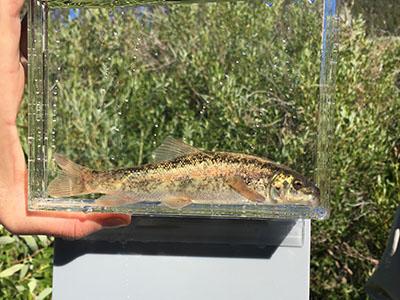
A Warner Sucker
Endemic to the lakes and tributaries of the Warner Basin in southeastern Oregon, the Warner Sucker was listed as Threatened under the Endangered Species Act in 1985.
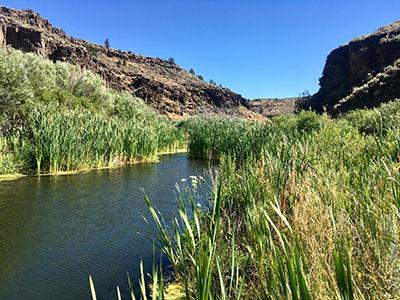
The Warner Basin
Warner Sucker are found in lakes and streams in the Warner Basin, a semi-arid subbasin of the Great Basin. They prefer low-gradient reaches of streams, such as this beaver pond.
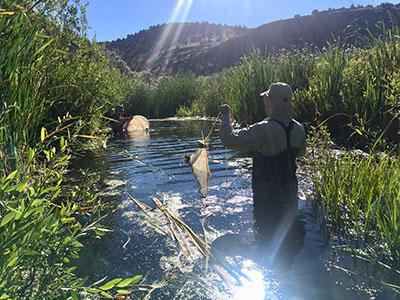
Checking Hoop Nets
ODFW biologists check hoop nets for Warner Sucker. Trapped fish are measured, marked, recorded, and released. This information is used to estimate the distribution, abundance, and demographic characteristics of Sucker populations.
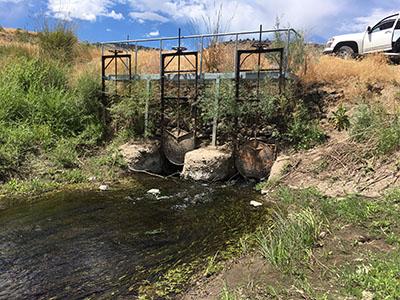
Irrigation Structures Can Create Barriers for Fish
Conservation efforts to support Warner Sucker include upgrading or augmenting irrigation structures to allow fish to more freely up and downstream. At this site, a rock ramp was constructed next to this structure, allowing fish to move upstream to spawn.
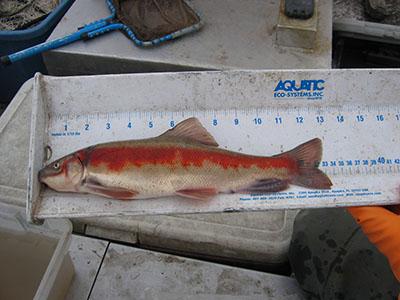
Spawning Colors
When the Warner Sucker begins it's Spring migration to spawn, males and females develop vibrant red colors along their sides.
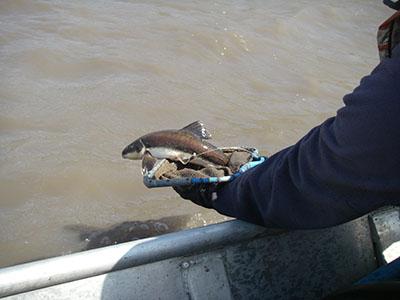
Releasing Radio Tagged Fish
Biologists implant Radio Telemetry tags in fish, which allows them be tracked in real time as they make their annual migrations from lakes to streams. This helps us learn when and where fish move through the habitats the occupy.
